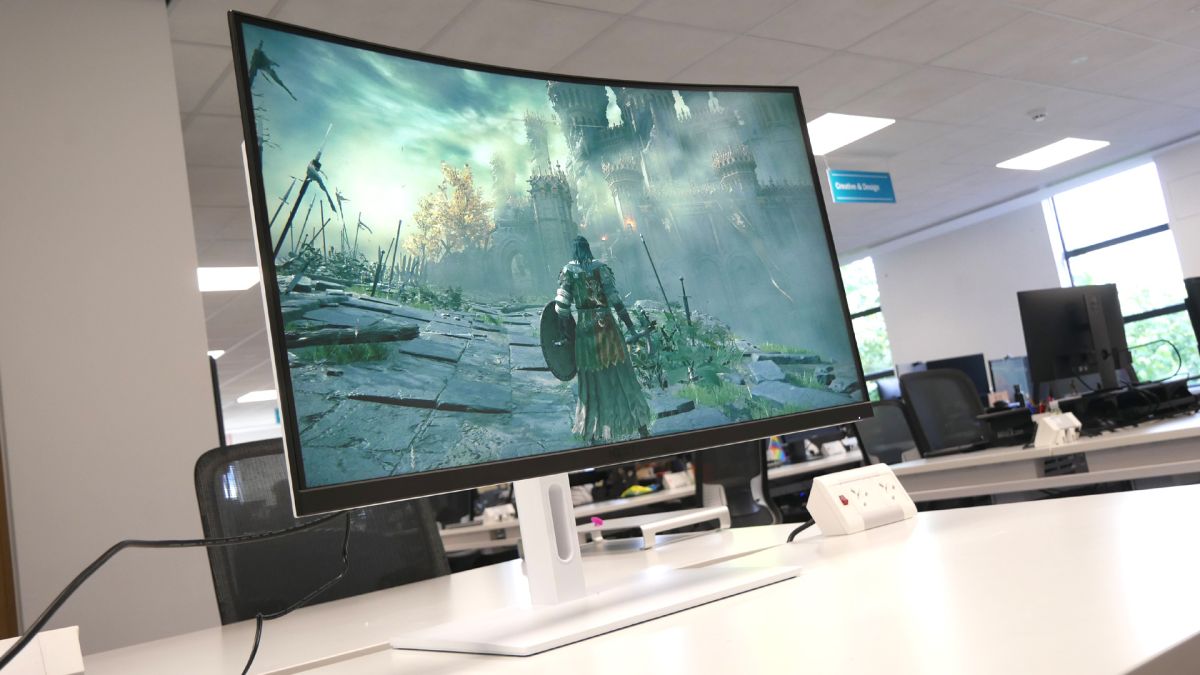NZXT Canvas 32Q Curved
🖥️
PC cases are even fully constructed PCs. That’s what we know best about NZXT. But the display? Not so much. Enter the new NZXT Canvas 32Q Curved. It’s a 32-inch, 1440p, and 165Hz panel, which is an immediate problem. When it comes to gaming monitors, is it better to get something from a screen specialist, like LG, and then optimize it for gaming? Or can gaming experts apply their expertise to the screen? Time to find out.
As far as headline specs go, there’s nothing special about the NZXT Canvas 32Q Curved. That’s fine, for sure. But a 32-inch VA panel with 1440p resolution, 165Hz refresh rate, 1ms response, and 300nits of brightness doesn’t set a new standard. Instead, it joins the fray with competitive, but not world-class, specs.
Speaking of specs, NZXT’s own numbers rate this VA panel with a static contrast ratio of just 1,000:1. You would typically expect at least 2,000:1, if not the 3,000:1 of modern VA panels. It is said that the 1ms response assertion is also via grayscale-to-grayscale rather than MPRT. Only Samsung has managed VA displays with 1ms GT and not MPRT before. curious.
For the record, the NZXT Canvas 32Q Curved does support HDR10 signal processing. But, with 300 nits of maximum brightness and no local dimming, you know how to practice. It’s not even close to true HDR. The panel’s colors aren’t terribly accurate either. NZXT rates the 32Q at 89 percent of the DCI-P3 color gamut and 99 percent of sRGB. Both numbers are down slightly compared to decent IPS panels. But in a gaming environment, this isn’t a huge problem.
However, the Canvas 32Q is a tune that bends to the 1500R, which is quite a bend. Curved screens are subjective at their best. But we think most people will agree that it makes more sense to use an ultrawide panel than a more traditional 16:9 monitor like this one. Of course, it won’t affect the experience much. But the curvature didn’t significantly improve this display either.
NZXT Canvas 32Q Bend Specifications
(Image credit: Future)
screen size: 32 inches
Panel Type: Virginia
Resolution: 2,560 x 1,440
brightness: 300nits
Compared: 1,000:1
Response time: 1ms
Refresh rate: 165 Hz
Color Coverage: 89% DCI-P3
HDR Support: HDR10
Adaptive Sync: FreeSync Premium, compatible with G-Sync
Connectivity: DisplayPort 1.2 x1, HDMI 2.0 x2, USB Type-C
price: $429(opens in a new tab) | £469(opens in a new tab)
Anyway, if the Canvas 32Q Curved looks mainstream, where is the NZXT good point? The first is design. It’s a fantastic display. And it’s beautifully built too. The main case is high-quality white plastic, while the metal stand is very well designed.
The stand can be adjusted for rotation, tilt and height, but cannot be rotated into portrait orientation. Strictly speaking, it’s also an optional extra. The NZXT Canvas 32Q Curved is pretty competitively priced in the US at $379 without the stand and $429 with the stand, while in the UK it’s £429 without the stand and £469 with the stand Sterling, a bit expensive. Anyway, it’s an interesting twist to be able to choose the stand. Ditch it, the screen offers a VESA 100mm x 100mm mount support, in fact NZXT will also sell you single mount and dual mount VESA arms as replacements for the factory mounts.
In addition to this, another obvious NZXT-specific feature is the CAM software. Essentially, it’s a Windows application that replaces the clunky monitor OSD menu. Not that NZXT’s OSD is particularly bulky. Like the OSD, it’s actually pretty smooth. But CAM applications are more powerful and configurable, allowing you to control various functions and settings without using the OSD, including making settings profiles on a per-application basis.
For inputs, you get HDMI, DisplayPort and USB Type-C and DisplayPort alt modes. Note that the latter does not support power delivery. So you can’t connect to the laptop with a single cable and drive the monitor and charge the laptop at the same time. That said, in case you were wondering, you can get 165Hz over USB.
(Image credit: Future)
Anywho, what to do with the actual image quality? Obviously, you need to be happy with the sizable pixels that come with a 32-inch panel and 1440p native resolution. This isn’t a crisp 4K display. This is more serious on the Windows desktop than in games. But it does damage the all-round, versatile appeal.
Also, this isn’t a monitor that shows you right away. For a VA panel, contrast isn’t great, and viewing angles are okay, not great. Also, as you’d expect from a maximum brightness of 300 nits, it’s not very intense at all. Dare we say it has a slightly old-fashioned feel, lacking the saturation and vibrancy of the best panels out there.
As for pixel response, there are three levels of overdrive available, and even the fastest settings are very useful with little visible overshoot or anti-ghosting. Perhaps unsurprisingly, due to the relatively limited overdrive, the 32Q doesn’t look as sharp and snappy as the best IPS panels out there. It’s just a little softer on fast movements.
Inevitably, HDR performance isn’t a highlight either. The panel lacks the required brightness and backlight modulation. It’s also worth noting that in panels running in HDR mode in Windows, the gamma for SDR content is a bit choppy. So unless you’re specifically watching or playing HDR content, you definitely don’t want it in HDR mode.
Not that we usually bother with HDR modes. Comparing HDR-heavy titles like Cyberpunk 2077 in SDR and HDR mode on this monitor, it’s hard to tell which is which.
All of this seems rather negative. But it’s not a bad monitor. For the most part, it performs almost as well as you would expect from the specs. This is a 300nit, 165Hz, 1440p (essentially) SDR gaming panel. It may not have the contrast you’d expect from a VA monitor. Not as responsive as the best IPS screens. But it’s by no means a mess. It’s fast. It looks great and is very well built.
So, the NZXT Canvas 32Q Curved isn’t a bargain. Nor is it flawless or world-class. But in this part of the market, it’s a solid option.
If we’re buying a 32-inch, 165Hz, 1440p, SDR panel, we’ll decide whether we think the styling and engineering advantages of this NZXT outweigh the slightly more vivid image quality of some of the alternatives. So yes, NZXT definitely does some things better than the established monitor makers. But the company still needs to learn more before getting a full picture of the big brands.
Check more articles in our categories Gaming & News et Anime.
Thanks for visiting we hope our article NZXT Canvas 32Q Curved
, help us and share the article on Facebook, instagram and e-mail with the hashtags ☑️ #NZXT #Canvas #32Q #Curved ☑️!














Leave a Review